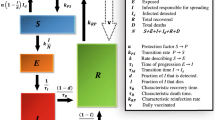Abstract
The paper considers discrete and continuous models of the epidemic propagation with a limited time spent in compartments. It contains a comparative analysis carried out for the influence of process parameters on both models. The problem of system identification is solved. Namely, we first estimated the accuracy of the solution of the inverse problem on the model data. Then the system is identified based on real data on the spread of COVID-19 in Kazakhstan, after which a forecast is made for the propagation of the epidemiological situation.
Access this chapter
Tax calculation will be finalised at checkout
Purchases are for personal use only
Similar content being viewed by others
References
Ross, R.: The Prevention of Malaria. John Murray, London (1911)
Kermack, W.O., McKendrick, A.G.: A contribution to the mathematical theory of epidemics. Proc. R. Soc. Lond. A 115, 700–721 (1927)
Bailey, N.: The Mathematical Theory of Infectious Diseases and Its Applications (2nd edn.). Griffin, London (1975)
Bacaër, N.: Le Modèle Stochastique SIS pour une Épidémie dans un Environnement Aléatoire. J. Math. Biol. 73, 847–866 (2016)
Wang, X.: An SIRS Epidemic Model with Vital Dynamics and a Ratio-Dependent Saturation Incidence Rate. Discrete Dynamics in Nature and Society (2015). https://doi.org/10.1155/2015/720682
Keeling, M.J., Rohani, P.: Modeling Infectious Diseases in Humans and Animals Illustrated Edition. Princeton University Press, Princeton (2007)
Sameni, R.: Mathematical Modeling of Epidemic Diseases; A Case Study of the COVID-19 Coronavirus. ar**v:2003.11371 (2020)
Krivorotko, O.I., Kabanikhin, S.I.: Matematicheskje modeli rasprostranenia COVID-19 (Mathematical Models of COVID-19 Propagation). Mathematical Center in Academcity, Novosibirsk (2021)
Mwalili, S., Kimathi, M., Ojiambo, V., Gathungu, D., Mbogo, R.: SEIR Model for COVID-19 Dynamics Incorporating the Environment and Social Distancing, vol. 13, p. 352 (BMC Res. Notes. 2020)
Unlu, E., Leger, H., Motornyi, O., et al.: Epidemic Analysis of COVID-19 Outbreak and Counter-Measures in France. medRxiv (2020). https://doi.org/10.1101/2020.04.27.20079962
Vynnycky, E., White, R.G. (eds.): An Introduction to Infectious Disease Modelling. Oxford University Press, Oxford (2010)
Huang, H., Wang, M.: The reaction-diffusion system for an SIR epidemic model with a free boundary. Discrete Contin. Dynam. Sys. B 20(7), 2039–2050 (2015)
Brauer, F., Feng, Z., Castillo-Chavez, C.: Discrete epidemic models. Math. Biosci. Eng. 7, 1–15 (2010)
Serovajsky, S., Turar, O.: Mathematical model of the epidemic propagation with limited time spent in exposed and infected compartments. J. Math. Mech. Comput. Sci. 4(112), 162–169 (2021)
Serovajsky, S.: Mathematical Modelling. Chapman and Hall/CRC, London (2021)
Conn, A., Gould, N., Toint, P.: Trust-Region Methods. SIAM (2000)
Acknowledgements
This research was supported by the Grant No. AP09260317 “Development of an intelligent system for assessing the development of COVID-19 epidemics and other infections in Kazakhstan” of al-Farabi Kazakh National University.
Author information
Authors and Affiliations
Corresponding author
Editor information
Editors and Affiliations
Rights and permissions
Copyright information
© 2023 The Author(s), under exclusive license to Springer Nature Switzerland AG
About this paper
Cite this paper
Turar, O., Serovajsky, S., Azimov, A., Mustafin, M. (2023). Discrete and Continuous Models of the COVID-19 Pandemic Propagation with a Limited Time Spent in Compartments. In: Kähler, U., Reissig, M., Sabadini, I., Vindas, J. (eds) Analysis, Applications, and Computations. ISAAC 2021. Trends in Mathematics(). Birkhäuser, Cham. https://doi.org/10.1007/978-3-031-36375-7_5
Download citation
DOI: https://doi.org/10.1007/978-3-031-36375-7_5
Published:
Publisher Name: Birkhäuser, Cham
Print ISBN: 978-3-031-36374-0
Online ISBN: 978-3-031-36375-7
eBook Packages: Mathematics and StatisticsMathematics and Statistics (R0)




